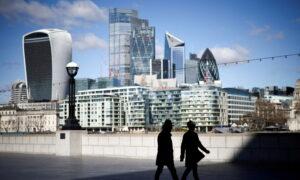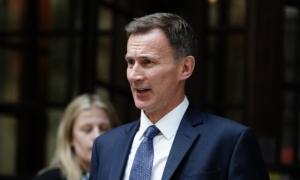UK’s Economy Bounces Back with Highest Growth Rate in Two Years
Chancellor Jeremy Hunt announced that the economy is on its way to full health as GDP expanded by 0.6 percent in the first quarter.
The UK economy has emerged from a shallow recession in the first quarter, showing the fastest growth in about two years, giving Prime Minister Rishi Sunak a boost before the elections.
According to estimates by the Office for National Statistics (ONS) released on Friday, GDP increased by 0.6 percent from January to March.
This growth followed two consecutive quarters of decline, meeting the definition of a technical recession.
It marks the fastest growth since the fourth quarter of 2021, when GDP rose by 1.5 percent.
Both Mr. Sunak and Chancellor Jeremy Hunt have praised the positive development, although Labour mentioned that it’s not the time for Conservative ministers to celebrate prematurely.
In response to the news, the prime minister mentioned that it signifies a turning point in the economy.
Mr. Hunt also expressed optimism, stating that the figures show the economy is on the path to “returning to full health” after the challenges of the COVID-19 pandemic and energy crises.
However, Labour’s shadow chancellor Rachel Reeves, vying to replace the chancellor in the next election, cautioned against premature celebration from Conservative ministers.
She stated, “The economy is still £300 smaller per person than when Rishi Sunak became prime minister.”
According to ONS estimates, first-quarter GDP growth was driven by the services and production sectors, which expanded by 0.7 percent and 0.8 percent, respectively.
In March, GDP grew by 0.4 percent, boosted by the service industry.
Notable growth was seen in the health and social services sector, administrative and support services, as well as wholesale and retail businesses.
Construction output experienced a decline in March, but the 0.4 percent drop represented a significant reduction from the 2 percent fall in February.
GDP per head increased by 0.4 percent in the first quarter, marking the first rise in two years, though it remained 0.7 percent lower than a year earlier, indicating continued pressure on living standards and productivity in Britain.
Comparatively, the UK’s first-quarter economic growth surpassed the euro zone’s 0.3 percent and the United States’ 0.4 percent growth.
Despite this, Britain’s recovery has been slower than that of other G7 countries.
By the end of the first quarter of 2024, the UK economy was only 1.7 percent larger than its late 2019 levels, with only Germany faring worse in the G7.
The Bank of England (BoE), which maintained interest rates at a 16-year high on Thursday, had anticipated 0.4 percent quarterly growth in the first quarter, followed by a smaller 0.2 percent increase in the second quarter, and a modest 0.5 percent growth for 2024 as a whole.
Officials on the BoE’s Monetary Policy Committee (MPC) suggested the central bank may begin cutting rates as early as June, but some economists believe stronger GDP growth could delay this move and fuel inflation.
Economists from Nomura, a Japanese bank, stated, “This is likely to be a surprise to the MPC and may result in upward revisions to inflation at the next Monetary Policy Report.”
Following the release of the ONS figures on Friday, the pound strengthened against the U.S. dollar.
Contributions from Reuters and PA Media were included in this report.





